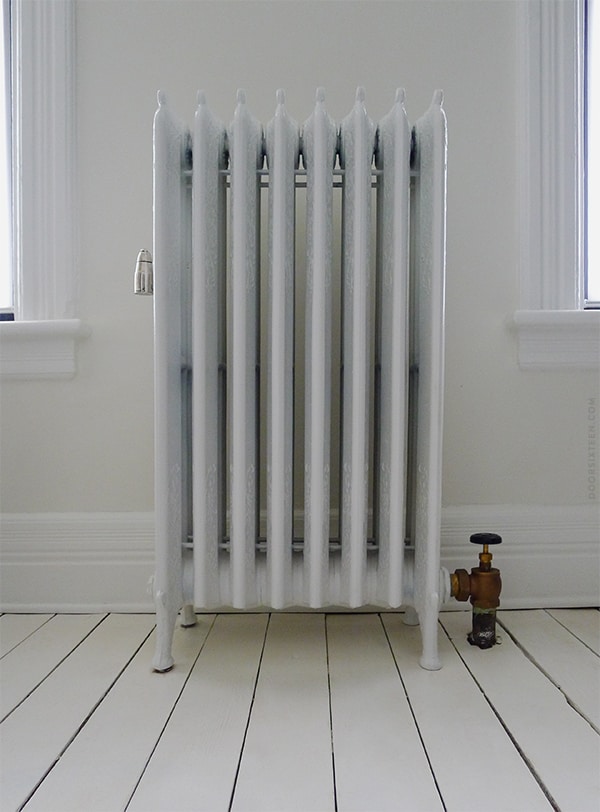
Last summer, I did a small budget cast iron radiator refinishing job for our kitchen. Very small—about $28. It went really well—I’ll most likely be doing the same thing for most of the other radiators in the house that are awaiting refinishing. Back in 2008, though, we went with a super-spendy alternative for two of them. We were in the middle of renovating the upstairs bathroom at the time and we’d decided to send out the sink and tub to be refinished off-site, so it made sense to throw in a couple of radiators. I’ve been getting a lot of questions lately about what we had done, so I thought I’d do a proper post and show off the results.
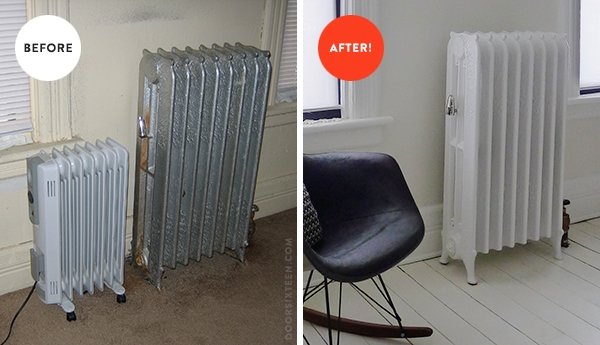
Before (2006) and after (2014)! It’s hard to tell from the before shot, but the radiator had a lot of rust buildup on it. Someone had recently given it a silver re-coat (note the overspray on the wall above), but there were layers and layers of peeling paint underneath. All those layers of paint make radiators less efficient, and as the bottom layers fail further, the top layer deteriorates pretty quickly. It’s a losing battle. At a certain point, you have to take the existing paint off and start over.
We bought the house during heating season, and this radiator’s valve was leaking a ton of water into the kitchen ceiling below it. We have a single-pipe steam system (as opposed to dual-pipe hot water), and I don’t think the steam was even making it through the body of the radiator—it was just condensing at the valve and leaking. Between that and the broken boiler, I understand why the tenants were using an electric space heater back there! We had a plumber in right away to disconnect the radiator and cap the line above the floor so the leaking would at least stop while we figured out what to do with that room.

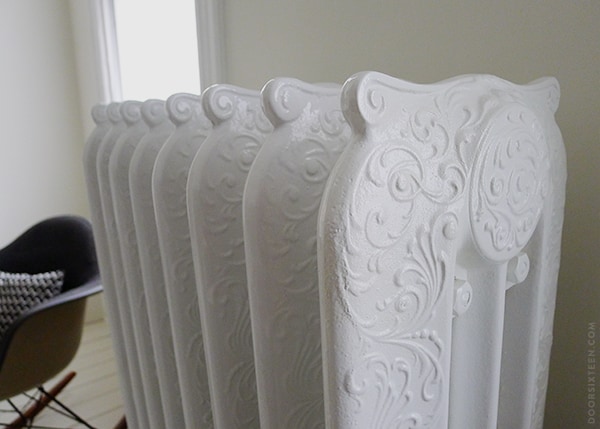
We used a local place to do our refinishing, Extreme Powder Coating in New Windsor, New York. They showed up with two burly guys who carried everything down the stairs, out the front door, and into the back of a Hummer. Let me tell you, moving two cast iron radiators, a cast iron sink, AND a cast iron clawfoot tub is no joke. This radiator alone probably weighs about 400 lbs, and clawfoot tubs are around 300…so…yeah. It was hard to watch them go down the stairs. I kept envisioning the guy on the bottom—who was walking backwards—losing his grip and being squashed under the tub.
A few weeks later (it took them longer than expected because sandblasting the tub took some trial and error), everything was redelivered. The detail on the radiator looks so crisp without all of the lumpy paint under it. Sandblasting removes everything down to the bare metal, so even just not having 100 years of filth between the fins is a relief. Powder-coating, by the way, is a relatively safe process in terms of toxicity—unlike spray paint. There are no solvents used (it’s a dry powder that gets baked on), and no VOC emissions. It’s also super durable, so a well-maintained radiator that’s been totally stripped and coated should last a very long time without needing to be re-coated.
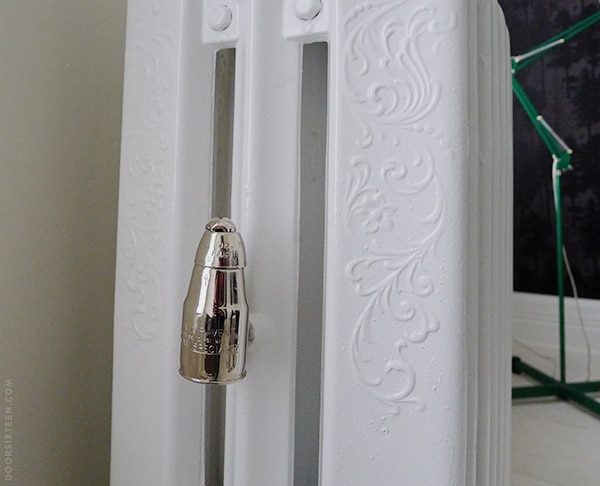
This winter, we replaced all of the vents on our radiators. Depending on the type, vents typically cost less than $20. They’re easy to change out, and it’s a simple fix that will get rid of steam whistling and sputtering. That’s the kind of thing I’m talking about when I mention radiator maintenance—if you have a leaky vent that’s dripping condensed steam, you’re going to wind up with rust. Just buy a new vent! Here’s a good instructional video from This Old House.
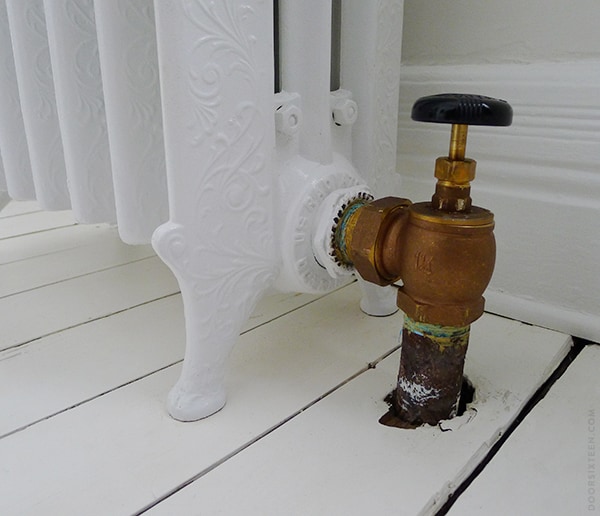
This is embarrassing to admit, but the refinished radiator sat, disconnected, in the studio for FIVE YEARS before we had the plumber come to install a new valve for us last fall. We had to change some piping in the basement beforehand, and we couldn’t do that until we dealt with the kitchen radiator…and, of course, the kitchen renovation would up dragging on for an eternity, so…that’s just how it goes. That room has been preeeeeeetty cold in the winters, let me tell you!
I still need to take care of the exposed part of the supply pipe. I’m going to paint it white with a enamel made for metal, and get a fancy brass flange to hide the chewed-up wood around the hole in the floor. I’m thinking about this pretty floral one, probably in white. I need one for the kitchen radiator, too, but I’ll go with bare brass in there.
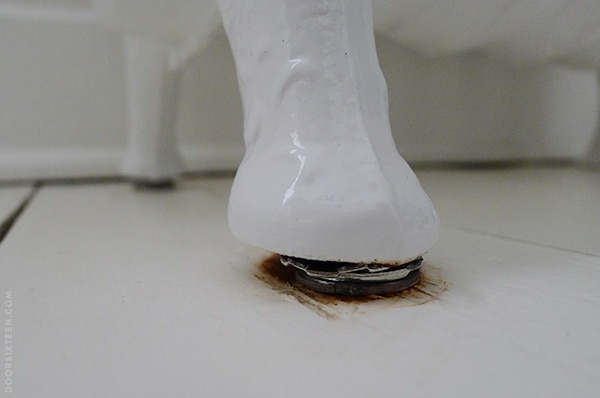
Steam radiators need to slope toward the boiler/supply pipe so that steam doesn’t get trapped in the system and condense. When you hear banging in radiator pipes, that’s trapped water that can’t be displaced by rushing steam. Large steel washers work well as shims! See the rust under the feet? Yup, that’s the result of a leaking vent. Fortunately we caught it in time, and the rust hasn’t spread or damaged the coating.
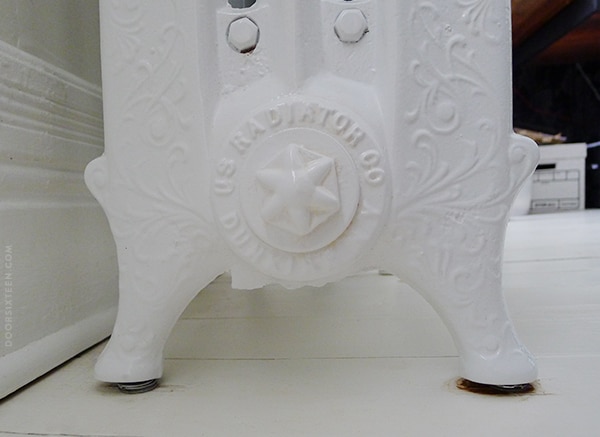
Most of our radiators were made by the US Radiator Co. in Dunkirk, NY. I had a tough time finding out much history about this company, but I did spend some time looking at their “complete” catalog (PDF). I’m not sure what year it’s from, but it definitely postdates the ornate radiators in our house. My guess is that most of our radiators are from around the turn of the century. I love that something so simple can still provide reliable, efficient heat 120 years after it was built, and that it looks so pretty while doing its job.
Costs for having cast iron radiators sandblasted and powder-coated can vary wildly depending on your location and the size of your radiator, but you can expect to pay $200-300. That doesn’t include the cost of having a plumber come in disconnect the radiator (and, just as importantly, cap the line) and reconnect it/install a new valve later, which can run you up a couple hundred dollars more if you can’t do that part yourself. So no, it’s not $28 worth of spray paint, but if you have a radiator that’s in really bad shape or you’re refinishing a bunch of other stuff at the same time (or if you just have bags of money lying around), the results are excellent.
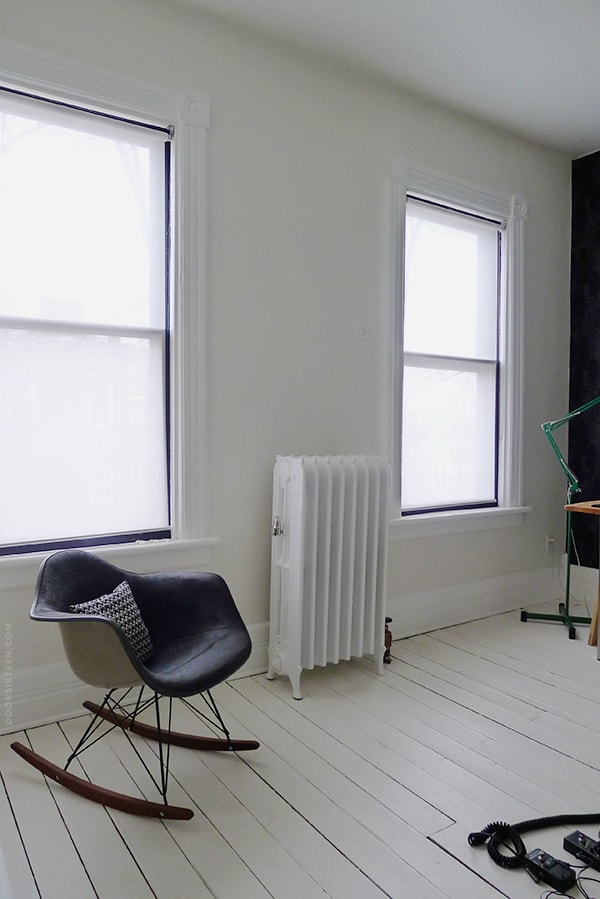
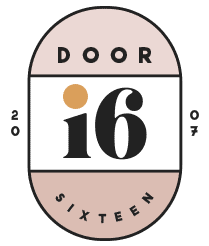
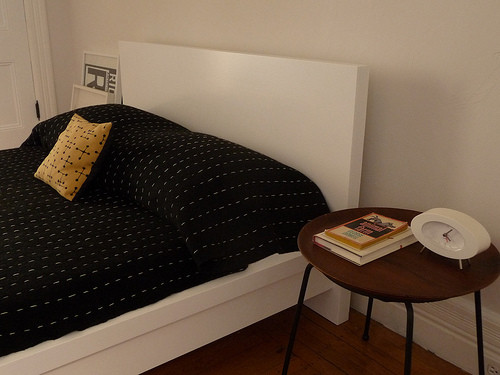
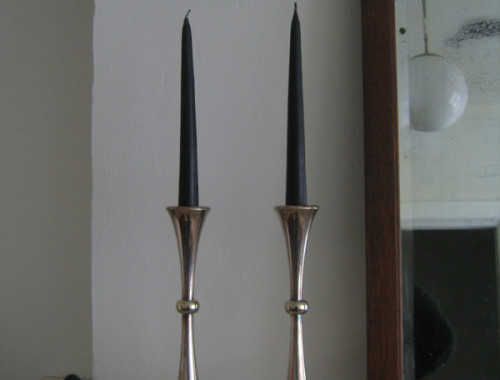
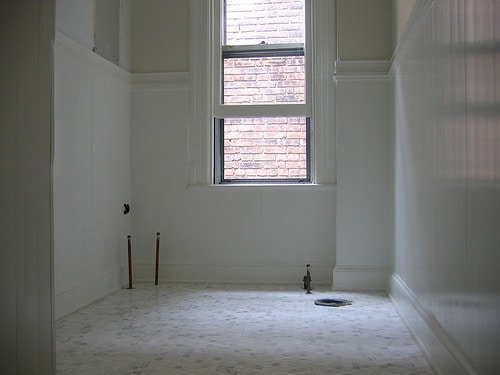

35 Comments
‘Steam radiators need to slope toward the radiator’– typo? I keep rereading it trying to figure it out.
Yep! Already fixed. 🙂
I didn’t know that about the banging sound. Interesting.
It’s so pretty. I’ve never had to deal with radiators but I think they look super cool. And kinda intimidating.
Thank you so much for posting this, especially the price range and the close ups of that beautiful detail. We have been slowly working on our 1910 house and it has some great ones that I would truly love to have redone “right” someday. This is inspiring!
Browsing through that ARC catalog just gave me an odd realization – I think the radiators in our downstairs bath were installed sideways! I screencapped a page of the catalog and blogged a picture of the bathroom – what do you think? 🙂
http://thehouseofdreams.wordpress.com/2014/03/23/radiators/
Yours look amazing!!
Holy cow, Julie, that’s pretty crazy-looking!! Yeah, I think it’s safe to say your radiators were mounted sideways by someone very creative. 🙂 🙂
Beautiful.
Never have had to live with radiators, but appreciate the info! Yours look stunning and congratulations on keeping the original look and feel of your lovely home. Seems to me that steam heat like that would be pretty energy efficient, depending on what heats the water? Sometimes those 19th century solutions make a lot of sense.
We just switched to gas from oil, which is a bit more efficient (and definitely cheaper), but unfortunately because it’s a steam system rather than hot water, the variety of boilers to choose from is somewhat limited. All in all, though, these radiators do a great job of heating rooms very quickly, and since they retain so much heat, they continue to radiate warmth even after the boiler has stopped.
Having an uninsulated house with 125-year-old windows, though…that’s a whole ‘nother story. We rely on the dogs for warmth. 😉
For what it’s worth, we have hot water radiators, and the consultant from the utility company who came to set up our conversion to gas sad that our 100 year-old cast iron radiators were very efficient—much more efficient than baseboard radiators. We have a very efficient boiler, but I’d still say that our heat bills haven’t been so bad this winter, and that’s with a VERY drafty mid-renovation house (missing ceilings, holes in walls…we’re a mess!). I love radiators!
It looks great! I had two of mine sandblasted when I had the kitchen renovated. They look so beautiful now. I chose a silver gloss powder coating. They also give off so much heat now that they’re hot to the touch! It’s really warmed up that cold room.
I never knew a radiator could look so pretty. I’m always just so impressed with all of your renovations.
Oy vey, I did not need to see this! We have a few really chippy radiators and others that are slathered with paint and caulk(!), and I’ve been trying to convince myself that a few cans of spray-paint is all they need. This radiator is SO BEAUTIFUL, though. I feel like we need to go for it for at least a couple of them. For, you know, energy efficiency reasons and all of that. And since we’ll probably soon be in the same situation what with the bathtub and sink…might as well throw in a couple of radiators…
It never occurred to me that I could buy fancy flanges. Now I want fancy flanges.
Caulk! On a radiator! Wonders never cease.
And yeah, there’s a fancy version of everything basic. Sigh. I’m using the lure of fancy flanges as incentive to refinish more radiators.
So gorgeous! I miss radiators. We have fairly unattractive hot water baseboards in our new house. Can you say a few words about your oil-to-gas conversion? Did you have the tank removed? Was the whole process expensive? It’s something I’d like to do down the line….thanks!
Liz, the whole boiler/oil tank thing is probably worthy of its own post but briefly: Yes, it was expensive, but mostly because we needed to buy a whole new boiler at the same time. If you already have a dual-fuel boiler, it will be much cheaper to switch over (assuming there’s already a gas line running to your house). And yes, we do have to have the oil tank removed—we have a certain amount of time (I think it’s a year in NYS, but don’t quote me) to do that, though, so we’re waiting until the weather is a bit better and we’ve had a chance to do a good clean out of our basement.
Those radiators are just stunning. It’s amazing what was underneath all that paint. And I would have never thought that the amount of paint that was on them would contribute to their efficiency! But then duh, that makes sense.
I’ve been meaning to leave a gushy comment on your blog for a long time now. Your style and eye for design is incredible, and has greatly affected (or is it effected? I never know) and influenced my style over the years. I don’t know how I came across your blog, but I’m hella glad I did. The thought, care and attention that has gone into renovating your home is so inspiring. My husband and I are renters at the moment, and you make me want to buy a house so I can start the same kind of adventure and projects.
xx A
Thank you, Alex, that’s so great to hear. 🙂 Not to get all gushy myself and stuff, but it’s very gratifying to know that I’ve helped people to feel like taking care of an old house and fixing stuff up isn’t scary…it’s fun and rewarding! I hope you and your husband get to live out your own house dreams someday. 🙂
Our house was switched over to forced air sometime in the 50’s or 60’s, and I wish they had just kept the radiators! To run forced air in our tiny storefront used up a ton of wall space, and we still have inefficient heating. Not to mention radiators are so much nicer to look at than bulkheads and floor ducts. I’m guessing it was a door to door salesman who convinced the previous owner to make the switch. They also got sucked into installing aluminum siding over the brick in the 70’s along with about 40% of our street. Must have been one hell of a salesperson.
Yeah, Newburgh is a good example of what’s sometimes referred to as “preservation by neglect.” A lot of the renovation/modernization trends of the ’60s and ’70s (aluminum or vinyl siding, replacement windows, forced-air heating, etc.) never took hold here because so many properties were turned into rentals that haven’t been maintained. That’s the one good thing that has come out of the absentee landlord/”slumlord” situation—things weren’t changed because there was no money or authority to change them. Now, with historic preservation rules in effect, the exteriors of homes here are at least protected.
A friend and I were just talking about their iron radiators the other day. Sharing this post with them now. 🙂
Love the radiator, but the guys who did the work are awesome! We had to sandblast and powder coat 9 radiators to replace the “modernized” baseboard system in our house. After searching, finding, and buying them an hour away, I hauled them home to have one service clean and pressure test them, another to sandblast them, and still another to powder coat them. Then I had to contract with safe movers to get them inside and up one flight of windy stairs. Totally worth the trouble though – much more comfortable than baseboard convectors, and the detail under the paint is just beautiful. Ours are American Radiator’s “Aetna Flue” models – see: http://bungalow-rescue.blogspot.com/2013/02/those-were-good-old-days-traditional.html
Wow, WJ, those radiators are VERY cool!! I love how deep they are. Really nice.
And yeah, I definitely agree—the guys who did the work are awesome. They really went beyond the call with this job, and it was the first time they’d done these types of pieces. We went back to them again when we needed the decorative iron work on our porch roof refinished, and that also came out beautifully.
I must admit it never wouldn’t have occurred to me to have mine cleaned on the inside. Hmmmm…
We had old (from the thirties) radiators in our old apartment, never had them renovated. Now we have flat, ugly, seventies electrically heated ones. We have had a few removed in renovations, but most are there, unused, since we heat our house with an equally ugly but very effective air pump, which also has an ugly outdoor part taking up part of our back patio. Covered by a wood construction it is tolerable, though I would not have allowed it in an older house… I console myself with thinking it kind of fit our house from ’73, it is a strangely modernist rowhouse with an equally strange front facade in red brick looking very British, in Sweden. Somehow it works and the good thing is that it works with modern, big windows, and the back of the house is mostly windows. (looking out to a wooded area)
That radiator is absolutely gorgeous! Is it weird that I get swoony over pretty radiators? Well, I do. Great information, as always! I’ll bookmark this for the day when I finally buy my dream Victorian to renovate.
The result looks well worth the effort and investment into the house! Thanks for sharing your experience. I’m currently living in a rented apartment that’s part of a big historical home with radiators that probably have a few coats of paint on them and ugh, the nasty paint chips and rust underneath! Not much we can do about it though but if it were our house, we’d likely shell out the money to sandblast and polish up the radiators too.
Oh that looks lovely! Thank you so much for all this radiator info. I grew up with forced air & no one I know has a steam boiler with radiators like I do so I learned so much from your post.
I had no idea old radiators could look SO GOOD! I’m used to seeing the ugly silver monstrosities. We’re dying to ditch the forced air in our 1917 American System-Built home … this post has just made us die a little more!
Oh my, now I have another item to add to my house to do list. Looks like we’ll have to save up another $1000 or so to make our old radiators look as stunning as yours! But what great information, just in case a grand or so ever lands in our laps!
Thanks for the info! Can’t beat these cast iron radiators…they are so beautiful and retain the heat.
I have a 70 year old Youngstown double porceline? sink and double drain board. What are the chances to refinish. actually only one sink is stained, the rest is in pretty good shape
I’m seeing this a bit late. I am going through the same thing with hot water radiators, not steam. I took a different route. I had the radiators sand blasted (actually I think they use something less abrasive, seems like he said dry ice?) and that was around $40 per. I bought a 3 stage hvlp paint gun system and used a high quality Benjamin More oil paint over a rust inhibitor. This is NOT low VOC and for the first month of heating season I could smell the fumes. I did the painting in summer and wish I would have run the heat for a while during the warm months with the windows open, but it also wasn’t horrible. I could smell them but it wasn’t overpowering or noxious. THis cost me less than $100 total per radiator and that includes the cost of sandblasting, the paint setup, the paint and primer. Oh, VERY important, if you use a paint gun with oil paint, you have to be very careful as it’s flammable and not healthy to breath. So, do it outside, or in an extremely well ventilated area. I set up a paint booth with good lighting overhead, 6 mil plastic on 3 sides and above, and finally on the back side of the booth I had 2 box fans blowing air outside creating negative pressure so paint aerosols and fumes would vent out. I used cheap furnace filters over the box fans to prevent the paint aerosols from actually exiting the building. And I was wearing a good mask/air filter with the proper canisters for the fumes. The reason that I did it myself was mainly based on cost. I did look into having them powder coated, but the local guy that did it charged a lot, he did not do sand blasting, and we wanted me to deliver and pick up the radiators. I might have went that route if he provided all the services and it was maybe $200 per. For the sand blasting though I found a local guy that did pick up and deliver them back, and he also sprayed them with a rust inhibitor after blasting them. And I do a lot of wood work and already had the paint gun and felt comfortable doing that. So it was the better and cheaper option for me. Getting the radiators back up to my second floor after I was done was not a picnic though. You definitely want help, and you need to think safety! For me that meant using a come along to secure the radiators as they went up the steps so that if either of us lost our grip, the other wasn’t getting crushed! Also, do your research. I don’t know why this is, but your paint selection and color choices are important. Who knew. I always liked the thought of a shiny bronze colored or silver colored metallic paint. Turns out they reduce the efficiency of the radiator. There are articles written about that. And darker colors, for whatever reason, heat better and are more efficient too. I’m assuming that this holds true for powder coating as well, but am not really sure. So, like this person did, I went with white in my bathroom where I actually repurposed some old cast iron baseboard heaters instead of radiators, but in the rest of the house I kept the radiators and used a very dark slate blue on that looks more like dark grey but it has a little blue in there. They look really nice. Something else that wasn’t mentioned in the article, but is very important, and that is to do a pressure test on the radiators. Before AND after you have them sandblasted and painted. I don’t remember now what pressure I used, but the information is available on the web. You do this before because if there is a leak it doesn’t’ make sense to do the rest of the steps, it needs replaced. And you do it after in case there is any damage from sandblasting, dropping it while working on it, etc. Nothing will ruin your day like lugging a 400 lb radiator up a story of stairs, placing it, hooking it up, repeating for all the other radiators, then turning on the system and discovering that 1 or more of your radiators now have a leak! Or worse, one was dropped and has a major crack to one of the fins and water or steam gushes out. And I seem to remember that on a steam system you should pressure test to 100 lbs and in a hot water system to 70 lbs. You’re looking for 2 things, first that it doesn’t explode or come apart because of a major crack, but you also want to make sure that it holds its pressure for a period of time. I did an hour. If you have a leak, you should not use the radiator, especially if you have a steam system.
Because I don’t have steam radiators and because it’s not a gravity feed system, I did not need to worry so much about pitch of radiators. However, metal washers are not the thing to use. They work in a pinch, but they rust. Every time you mop, or if there’s any leaks, etc. Plus, if you have wood floors they chew into them and leave an indent. A better option is wood or felt. They make a really solid felt pads to protect wood floors and you can cut what you need. Go with a thinner set for the one side, and a thicker set for the higher side. Or, use a round wood cutout. My house was constructed in the late 20’s and I’m pretty sure everything was original. All my radiators had a wood piece under each of the radiator legs and they were pitched toward the effluent side. Based on the pipes used in the system I can say with certainty that when first installed, it was a gravity feed system. But now it uses a Taco circulator pump and has for at least 30 years and probably longer, so I know that the pitch was done either at the beginning or very early in the systems life.
Ok, I know that’s a book, but maybe it will save someone from a disaster. BTW, I did not have any leaky radiators and did not learn the hard way. I researched quite a bit before I tackled the project. I was doing a gut job on my entire first floor and I re piped some of my heating system as well as I relocated a couple radiators and replaced one with the cast iron baseboard and there were a couple rusted pipes that I had concerns on so I replaced those while I had the chance.
Good luck to anyone embarking on a similar project.
Hi Michael! Just to clarify, the individual you refer to as “this person” is me, and this is my blog. This is a personal blog post about my experience refinishing a radiator (12+ years ago!) in a house I used to own—it’s not an “article,” nor is it intended to be a complete guide to radiator maintenance and restoration. I mention this solely as clarification, since your lengthy comment seems to suggest you came here looking for something that this isn’t. 😉
I’ve read about powder coating resulting in “leaky valves”. Did you have any issue with that?
Nope.